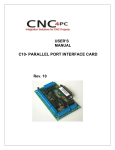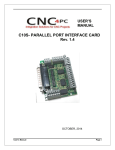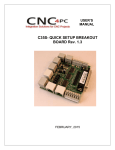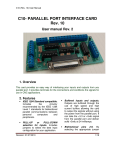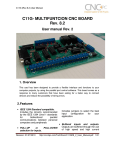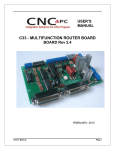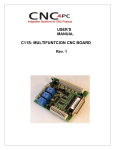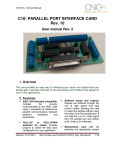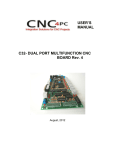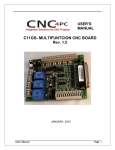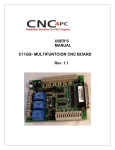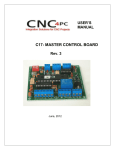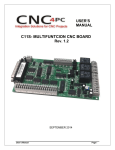Download User`s Manual Template
Transcript
USER’S MANUAL C10S- PARALLEL PORT INTERFACE CARD Rev. 1.2 June, 2012 USER'S MANUAL TABLE OF CONTENTS Page # 1. OVERVIEW ......................................................................................................................... 1 2. FEATURES ......................................................................................................................... 1 3. SPECIFICATIONS .............................................................................................................. 2 4. BOARD DESCRIPTION ...................................................................................................... 3 Using configuration jumper.................................................................................................. 4 Using the COM configuration jumper .................................................................................. 4 Using the Pins 2-9 direction jumper. ................................................................................... 5 5. SPECIAL FUNCTIONS ....................................................................................................... 5 Using the Pull-up or Pull-down selection jumper for pins 10, 11, 12, 13 and 15. .............. 2 Enable pin. ............................................................................................................................. 2 6. WIRING: ............................................................................................................................. 2 Connection instructions ....................................................................................................... 3 a. 7. Requirements: ............................................................................................................... 3 FUNCTIONAL BLOCK DIAGRAMS ................................................................................... 3 Bidirectional pins simplified block diagram ........................................................................ 3 Dedicated Inputs simplified block diagram ......................................................................... 4 8. WIRING DIAGRAMS .......................................................................................................... 4 Connecting Switches or push button. ................................................................................. 5 Connecting NPN sensors. .................................................................................................... 5 Connecting PNP sensors. .................................................................................................... 8 Other connections. ............................................................................................................... 9 9. 10. DIMENSIONS ................................................................................................................... 10 FREQUENTY ASKED QUESTIONS: ............................................................................ 11 DISCLAIMER: .......................................................................................................................... 11 User’s Manual Page i 1. OVERVIEW This card provides an easy way of interfacing your inputs and outputs from you parallel port and Smooth Stepper controller. It provides terminals for the connections and conditions the signals for use in CNC applications. 2. FEATURES IEEE 1284 Standard compatible. Includes the circuitry recommended by the IEEE 1284 Level 1 standards for bidirectional parallel communications between personal computers and peripherals. Smooth Stepper controller compatible. Includes a pin header to connect directly the SS using a standard ribbon cable. PULL-UP or PULL-DOWN selection for inputs. Includes jumpers to select the best input configuration for your application. Buffered inputs and outputs. Outputs are buffered through the use of high speed and high current buffers allowing the card to output the signals without using the power from the parallel port. It can take the +3.3 or +5vdc signal from the parallel port and deliver solid +5vdc at 24 milliamps. Bidirectional pins 2-9. By selecting the appropriate jumper setting you can use these pins for input or output. If you use a second parallel port and set it to work in a bidirectional way, you get a total of 34 I/O pins. Output pins 1, 2, 3, 4, 5, 6, 7, 8, 9, 14, 16, 17. Or 1, 14, 16, 17. Input pins 10, 11, 12, 13, 15. Or 2, 3, 4, 5, 6, 7, 8, 9, 10, 11, 12, 13, 15. Input and output pins with close by ground or +5vdc connections The common terminal to pins 2-9 can be ground or +5vdc. Forget about grounding problems. Easily connect your pin by using your close by ground connection. No need to be an electronics expert to ground all your stuff. The board has a jumper that allows you to select if the common terminal to pins 2-9 will carry a ground or +5vdc. So if you are connecting encoders or proximity switches, you can select it to ground. If you are connecting Geckodrives or limit switches, you can set It to be +5VDC. Input pins 10, 11, 12, 13, 15. User’s Manual Page 1 External Enable Pin (EN). The board has a pin that allows you to enable/disable all the outputs at once. The board requires +5vdc in the EN pin. If it is not present, it will send all the outputs to ground. You can use this to enable or disable the system manually, or you can install an external Safety Charge Pump or other external safety monitoring device. Works directly with popular CNC hardware and software. Such as Gecko drive or Rutex, and parallel port control software, such as mach2, Linux EMC, Turbo CNC, and others. (Not all tested). All TTL 5VDC signals. Interface directly with parallel port interface products and other CNC4PC cards. 5VDC (TTL) cards are very common among automation devices. Screw-On connections for all terminals. You only have to screw-on the wires to make all your connections. 3. SPECIFICATIONS DIGITAL INPUT SPECIFICATIONS On-state voltage range 2 to 5V DC Maximum off-state voltage 0.8V Maximum operation frequency 4 MHz Typical signal delay 10nS DIGITAL OUTPUT SPECIFICATIONS Maximum output voltage (5V power supply voltage) + 0.5V Typical output current 24mA Maximum off-state voltage 0.44 V Maximum operation frequency 4 MHz Typical signal delay 10 nS Time of transition to high impedance state 12 mS* User’s Manual Page 2 4. BOARD DESCRIPTION Board Pinout User’s Manual Page 3 Using configuration jumper. Using the COM configuration jumper There is a jumper (X7) that allows you to select +5VDC or GND for the COM pins. 1-2: COM= GND 3-2: COM= +5VDC User’s Manual Page 4 Using the Pins 2-9 direction jumper. There is a jumper (X6) to select the pins 2-9 direction. 1-2: OUTPUTS 2-3: INPUTS 5. SPECIAL FUNCTIONS Using the Pull-up or Pull-down selection jumper for pins 2-9. Jumper (X4) allows change the input configuration for pins 2-9. Using the Pull-up or Pull-down selection jumpers for pins 2-9 the input voltage is pulled through a 4.7Kohm resistor to up or down in this way: 1-2: PULL-DOWN 2-3: PULL-UP User’s Manual Page 5 Using the Pull-up or Pull-down selection jumper for pins 10, 11, 12, 13 and 15. Jumper (X5) allows change the input configuration for pins 10, 11, 12, 13 and 15. Using the Pull-up or Pull-down selection jumpers for those pins will pull them up or down through a 4.7Kohm resistor: 1-2: PULL-DOWN 2-3: PULL-UP Enable pin. The card must be provided with a 5VDC signal to enable operation. This feature has been added to externally control the status of the outputs. An external switch or a Safety Charge Pump can be added to provide the enabling signal. When the enable signal is not present, output signals sent high impedance state. If this function is not required, an jumper can be placed between +5vdc and the EN terminal. It has an internal 4.7kOhm pull-down resistor 6. WIRING: The Parallel Port Interface Card has a very basic design that provides the flexibility you look for on CNC projects. +5VDC POWER SUPPLY WARNING: This card must have the power supplied while it is connected to the PC. If power is removed to the card while it is connected to the PC, noise can be introduced to the output lines. This can create a dangerous situation as relays or other devices that might be connected to this card could get activated. User’s Manual Page 2 Connection instructions a. Requirements: It requires a 5VDC @ 400 milliamps power supply to operate. This power can be taken from the computer’s power supply or USB port. Consider using the A3 – USB Power Cable found under Accessories in the website. WARNING Check the polarity and voltage of the external power source and connect the 5V and GND (X1). Overvoltage or reverse-polarity power applied to these terminals can cause damage to the board, and/or the power source. Follow the steps bellow. Step 1. Set the configuration jumpers (X4, X5, X6 y X7) as are required by your system. Note: Is important to understand the selection jumper functions (see section 4.1) and to know the input and output features of the devices to be connected to this board to reach a good couple. Step 2. Ensure that all external power sources are set to OFF. Step 3. Connect the power supply to the Power Inputs Connectors (X1). Step 4. Connect the parallel cable coming from the PC to the Female DB25 Connector (X3). Note: If this board is not connected to the PC, the outputs will be deactivated. Step 5. Connect to the board the components of the system. Step 6. Turn on the external supplies and check that the power led indicator (X2) lights. Step 7. Apply 5V to the enable pin (X8) to activate the outputs. 7. FUNCTIONAL BLOCK DIAGRAMS Bidirectional diagram pins simplified block Fig. 1 Simplified functional block diagram for the 2-9 pins. User’s Manual Page 3 A Pull-up or Pull-down selection jumper allows selecting the configuration for the all bidirectional pins (2-9) when they are set as inputs. Outputs simplified block diagram Fig. 2 Simplified functional block diagram for the outputs. Dedicated diagram Inputs simplified block Fig. 3 Simplified functional block diagram for the inputs. A Pull-up or Pull-down selection jumper allows selecting the configuration for the all dedicated inputs (pins 10, 11, 12, 13 and 15). 8. WIRING DIAGRAMS While this board supports only TTL +5VDC signals, different kind of sensors, switches using different voltages can be connected using the diagrams that follow: Note. This board has two possible inputs banks, (bidirectional pins: 2-9) and (dedicated inputs: pins 10, 11, 12, 13 and 15), and all the inputs of the same bank have the same configuration. The below wiring diagrams are an example, any input can be used for the connections. Note. The bellow wiring diagrams require setting the inputs to use pull-down resistor. User’s Manual Page 4 Connecting Switches or push button. Fig. 3 Wiring diagram to connect switches. Connecting NPN sensors. Fig. 4 Wiring diagram to connect NPN open collector proximity sensors. User’s Manual Page 5 Fig. 5 Wiring diagram to connect in parallel NPN open collector proximity sensors. Connecting NPN open collector proximity sensor with the C10 R1 Value (12V) R1 Value (24V) Aprox. 10KΩ Aprox. 25KΩ Fig. 6 Wiring diagram to connect NPN proximity sensors with internal pull up resistor. User’s Manual Page 6 Some NPN proximity sensor has a pull-up resistor (R1) internally. It is necessary to know its value in order to connect safely the sensor with the BOB. Follow this recommendation: Connecting NPN open collector proximity sensor with the C10 (R1+R2) Value (12V) (R1+R2) Value (24V) Aprox. 10KΩ Aprox. 25KΩ Calculating the R1 value. Note: Rx is the unknown resistor value. RX = VEX.(R/V) - R (1) Where: VEX is the external power supply voltage V is the voltage across the R resistor An external resistor and a voltmeter are required to calculate the internal resistor (Rx) value. Note. The user should know the R value to do this operation. A 4.7KOhm @ 1/2W is recommended. SAMPLE: if you are using a 12V power supply (VEX), and using a 4.7KOhm as external resistor (R), then the voltage across R should be 6V, using the equation 1, the Rx value is 4.7KOhm. User’s Manual Page 7 Connecting PNP sensors. Fig. 7 Wiring diagram to connect PNP proximity sensors Connecting PNP proximity sensor with the C10S User’s Manual R Value (12V) R Value (24V) Aprox. 10KΩ Aprox. 25KΩ Page 8 Other connections. Other connections can be implemented by setting the inputs to pull-up resistor. This example shows how to do an Auto Tool Zero by setting the inputs with pull-up resistor. Fig. 8 Wiring diagram to do an “Auto Tool Zero” Other wiring diagrams samples are shown in the next links. http://cnc4pc.com/Tech_Docs/E_STOP_N_EN_Wiring.pdf http://cnc4pc.com/Tech_Docs/E_STOP_N_SCHP.pdf http://cnc4pc.com/Tech_Docs/C10R8_WD2.pdf User’s Manual Page 9 9. DIMENSIONS All dimensions are in Millimeters User’s Manual Page 10 10. FREQUENTY ASKED QUESTIONS: Q: The power LED on the board can light even if the board is not connected to power. Is this normal? A: Yes, the board can steal enough power from the parallel port to light the LED, not for reliable operation. An external regulated 5vdc that can supply at least 500mA should be used. If you are worried about false signals triggering out, you should use the EN terminal to disable the outputs. Q: I have power the board and connect it to the drivers, but the signals do not get to the drivers. A: Three conditions must be met to enable the outputs and allow signals to get through: - The board needs to be connected to a PC using a parallel cable that uses pins 1-25 as there is a watchdog on pins 18 and 19 that disables the outputs if the board is not connected to a PC. There are some parallel cables out there that use only pins 1-17, use a multimeter to verify continuity between these pins. - You should have 5vdc on the EN terminal. This is for external hardware disable on the board. You can use a jumper between the 5vdc in the power terminal and the EN terminal. - In the case of boards with built in Safety Charge Pump, the SCHP must be configured and active, or you can disable the SCHP in the board by moving the jumper to the disable position. DISCLAIMER: Use caution. CNC machines can be dangerous machines. Neither DUNCAN USA, LLC nor Arturo Duncan are liable for any accidents resulting from the improper use of these devices. The C10 is not a fail-safe device and it should not be used in life support systems or in other devices where its failure or possible erratic operation could cause property damage, bodily injury or loss of life. User’s Manual Page 11

















